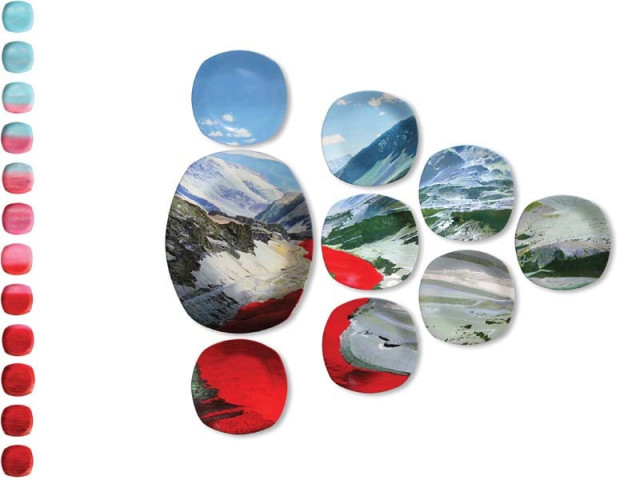Conflict in colour
Adeela Suleman depicts some aspects of war through art

Adeela Suleman depicts some aspects of war through art. PHOTO COURTESY: CANVAS GALLERY
At her current solo show at Canvas Gallery, titled ‘Dream of Carnage’, Adeela Suleman conveyed how this colour can signify much more than its immediate associations. With mediums spanning video installations, ceramics, metal and wood, Suleman’s works were a reminder of ideological and physical conflicts in Pakistan, as well as the state of war and suffering on a larger scale.
‘Dream of Carnage-1’ displayed a series of 12, 9x9-inch ceramic plates in linear, horizontal fashion. As the eye travelled over the plates successively, the sky-blue morphed into a deep pink, reminding one of a sunset view from an airplane window. Things took a darker turn as the pink further transformed into a blood-red hue that altered the meaning of the work completely and signified the advent of violence over a peaceful place. This piece made one feel like an airplane passenger who, upon viewing impending atrocities from afar, is unsure of where he could safely land; a very poignant reflection of how many Muslims, refugees and other minorities feel all over the world today.
‘Dream of Carnage-3’ displayed similar glossy ceramic plates forming a postcard-like image of a mountainous region, perhaps the Northern Areas of Pakistan. Here, the familiar was presented with an element of shock as the river appeared blood red — a literal depiction of the Urdu term ‘khoon ka darya’. It was interesting to note how the mere change of colour brought with it so many connotations and questions: Why has the world around us become so steeped in violence and danger that no place is safe from it? Or rather, why have differences in religion and ideology become such a bone of contention that they increasingly cause bloodshed?
On metal plates with ornamental frames in the ‘Dread of night’ series, Suleman depicted gory battle scenes appropriated from Mughal miniature paintings of the 16th -17th centuries, replete with cut-off heads oozing blood. With enamel paint on ornate ceramic plates placed on wood carving, she displayed conventional Mughal scenes, but with a twist: lovers in courtship, with the woman deceptively carrying a scythe, and Mumtaz Mahal on her throne, placed atop water. By including such periodic references in her work, Suleman reinterpreted and recycled age-old commentary to show us how little things have changed over time, if not become worse.
‘Don’t Despair, not even over the Fact that you don’t Despair’ also struck the viewer. This incredibly blurred video installation seemed to innocently depict people playing football at first, till many shocked viewers realised it was the same gory video of people playing with severed heads in Pakistan that had gone viral a few years ago.
By displaying most of her work in ornamental yet delicate ceramics, Suleman displayed beauty laced with the aftermath of violence in today’s fragile world. She also brought to us information we have become numb towards, to be looked at anew, while also questioning our associations.
Shanzay Subzwari is an artist and art writer based in Karachi. She tweets @ShanzaySubzwari
Published in The Express Tribune, Sunday Magazine, December 20th, 2015.



















COMMENTS
Comments are moderated and generally will be posted if they are on-topic and not abusive.
For more information, please see our Comments FAQ